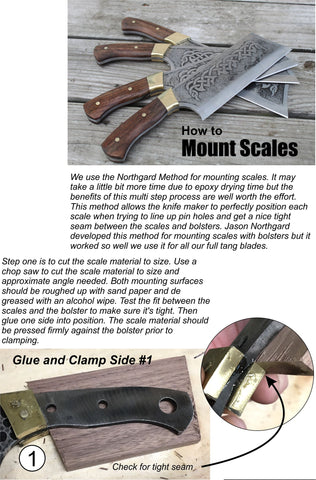The Complete Online Guide to Knifemaking, MOUNTING HANDLES
The Complete Online Guide to Knifemaking, MOUNTING SCALES

We use the Northgard Method for mounting scales. It may take a little bit more time due to epoxy drying time, but the benefits of this multi-step method are well worth the effort. This method allows the knifemaker to independently and precisely glue each side of the handle into position. This is especially important when establishing a tight seam between scales and bolsters. The steps are simple, glue and clamp on an oversized scale side into position. If bolsters are used, they would already be in place and the scale material should be pressed firmly against the bolster prior to clamping. Once dry, flip the blade scale side down, rest it on top of a piece of scrap wood, and head over to the drill press. Clamp the knife for safety and drill the pin holes using the pre-drilled holes in the knifes tang as guides. Using a backer board under the scales is important because it helps to prevent splintering and blowouts when drilling the pin holes. Next step is to rough trim excess material off the scale with either a band saw or scroll saw. Then, epoxy the second side into position. Again if bolsters are used, press the material firmly against the bolster before clamping. If bolsters are not used, align the forward edge to match side #1. After the second side dries, it's back to the drill press. This time the knife is clamped, and the drill uses the pinholes through side #1 as its guide. The end results are scales that have been aligned and glued in place and pin holes which have been drilled square through all three pieces.




Hidden Tang Handles
On hidden tang knives, there are a couple options to secure the handle material. Even though they are hidden. Handles can still be secured with epoxy and pins. Other options include threading the end cap to create a nut that would lock the handle into place. If pinning, the pin hole or holes would be drilled through the handle and tang after the handle block had been glued in place. This is only possible on blades which were differentially hardened leaving the tang soft enough to drill through. Hidden tangs can also have the tang peened to secure the handle block in place. The tang, in this case, would protrude through the end cap and would be peened over with a hammer creating its own rivet.
Check out our Knife making tools, huge assortment of topic specific how-to knife making videos, our Complete Online Guide Knife Making and our New Book Introduction to Knifemaking by Dan Berg and Jason Northgard.

